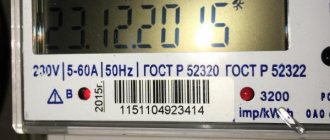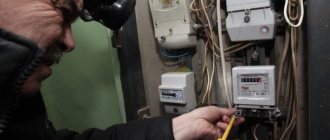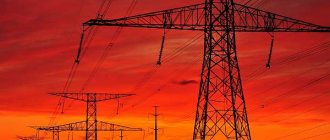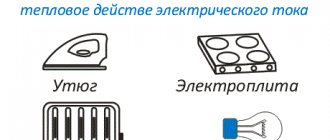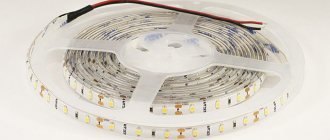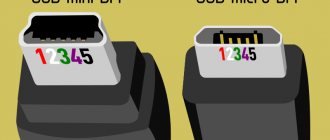Electricity is a type of utility service that you cannot do without, but it is also quite difficult to pay for it.
In addition to various energy saving techniques, there is another alternative way to save electricity - install a special meter and use a night tariff.
By using basic electrical appliances at night, you can significantly reduce your utility bills.
Night electricity tariff: what time does it start and when does it end? What else do you need to know and how to manage your time? The answers to these questions are in our article.
What types of counters are there?
An electric meter is a device that keeps track of how much electricity you use. How much electricity he burned is how much he will show on the display in kilowatt-hours. Then for these kilowatt-hours you will need to pay the energy supply organization at your tariff.
Tariffs vary. Firstly, they depend on the region. For example, in Moscow you will have to pay 4.87 R per kilowatt-hour for a single-tariff meter, and in the Istra district of the Moscow region - 3.89 R. Secondly, the meters themselves may have different tariffs. I'll tell you more about this. Tariffs are usually set for a year, in some regions from July 1, in some - from January 1.
In the article I will use the tariffs that were in effect in March 2020 in Moscow
A single-tariff meter operates at only one tariff all the time. Its readings do not depend on the time of day. A kilowatt-hour of electricity will cost the same both day and night.
The cheapest single-tariff meters do not even have a display. In this case, the readings are displayed the old fashioned way - on rotating wheels.
Their operating principle is not the same as multi-tariff ones, which is why they are cheaper
A two-tariff meter is a meter where the tariff depends on the time of day. The device shows on the screen the consumption of kilowatt-hours in two different time intervals, T1 and T2, as well as the total consumption.
Standard time intervals:
- T1 - from 7:00 to 23:00;
- T2 - from 23:00 to 7:00.
And such a meter, if desired, can be connected to one tariff, then it will work as a single-tariff Three-tariff - the same meter as a two-tariff, but it has three time intervals:
- T1 - from 7:00 to 10:00 and from 17:00 to 21:00;
- T2 - from 23:00 to 7:00;
- T3 - from 10:00 to 17:00 and from 21:00 to 23:00.
Two-tariff and multi-tariff meters have displays on which readings at different time intervals replace each other. The meter then shows the total consumption.
The meters also have parameters such as rated and maximum currents. An ordinary comfortable apartment is not a manufacturing enterprise with high energy consumption. Most modern electricity meters are designed for currents from 5 to 60 A.
Save on housing and communal services
If the load is less than 5 A - this is the rated current - then the device will produce an error and it is not known who will benefit from this. If all consumers in the apartment consume more than 60 A - this is the maximum current - the device may fail. But for an ordinary apartment this is unlikely, so you can ignore these parameters.
This is the cheapest three-tariff meter from Leroy Merlin. It's just a shame that it doesn't have very good reviews. People write that it is programmed by default for one tariff and needs to be reprogrammed for three
Multiple tariffs, what is it and why?
Let's look at the example of tariffs of Novosibirskenergosbyt OJSC in Novosibirsk:
| 1 | One-rate standard tariff | ||
| rate | RUR/kWh | 2,34 | |
| 2 | One-rate tariff differentiated by two zones of the day | ||
| Daytime zone (peak and half-peak) | RUR/kWh | 2,58 | |
| Night zone | RUR/kWh | 1,85 | |
| 3 | One-rate tariff differentiated by three zones of the day | ||
| Peak zone | RUR/kWh | 2,88 | |
| Half-peak zone | RUR/kWh | 2,34 | |
| Night zone | RUR/kWh | 1,85 | |
A little history.
The idea of multi-rate tariffs was invented during the Soviet era at the time of technological upsurge. The country had powerful factories and work shifts began and ended at the same time. Now imagine the situation that in a region with a powerful steel production, a work shift began and all factories began to simultaneously consume energy, creating a load on the system. Moreover, the main load of the system occurs from 8:00 to 16:00. At this time, the likelihood of accidents in the system increases, since the power is almost at maximum. To align the graphs, a differential accounting system was invented. The country's leadership tried to optimize the work process and suggested that enterprises change work shifts, reducing the workload from 8 to 16 hours.
The era of households.
After the collapse of the USSR, households became the main consumer of electricity in many regions. The life of most people begins with getting up at 7-8 in the morning and, as a rule, preparing breakfast. On a regional scale, it turns out that many people turn on the kettle and/or stove at one time. In this case, we get the first maximum in consumption from 7:00-8:00. After 5:00 pm, most people come home and start turning on electrical appliances, creating a second maximum from 5:00 pm to 9:00 pm. Most regions of our country are based on this load schedule, due to reduced production capacity.
Nonlinearity of load graphs
To equalize the load schedule and, as a result, increase reliability, differentiated tariffs were developed. Imagine how convenient it would be if you had a straight line on these graphs, rather than a curve with obvious maximums and minimums.
Now let's get back to tariffs
Differential tariff for two zones
| 07:00-23:00 | Day zone | RUB 2.58/kWh | We pay more than standard |
| 23:00-07:00 | Night consumption (minimum) | 1.85 RUR/kWh | We save |
As we can see from the table, the differentiated tariff for two zones offers subscribers a reduction in the cost of electricity at night and an increase in the cost during the day from 7:00 to 23:00.
Differentiated tariff for three zones
| 07:00-10:00 | First maximum | RUB 2.88/kWh | We pay more than standard |
| 10:00-17:00 | Half maximum | RUB 2.34/kWh | We pay as per the standard rate |
| 17:00-21:00 | Second maximum | RUB 2.88/kWh | We pay more than standard |
| 21:00-23:00 | Half maximum | RUB 2.34/kWh | We pay as per the standard rate |
| 23:00-07:00 | Night consumption (minimum) | 1.85 RUR/kWh | We save |
Now let’s move to everyday realities and try to analyze the multi-tariff nature.
The tables show that the rationale for switching to multiple tariffs is achieved only by shifting electricity consumption at night. If you have a nightclub, then the choice is obvious. If you are a simple subscriber, will you be able to wash things at night, cook food in a steamer or on the stove at night, heat the boiler at night and use only the lighting at maximum? I think that achieving these events is very difficult. You need to understand that a person has certain biorhythms in which he performs the maximum useful actions. Only automation of household appliances, with the ability to work at night, can provide significant savings!
Of course, the idea of load leveling is a very powerful solution for maintaining grid reliability and energy efficiency, but on the utility side, we would suggest reducing the cost of electricity during half-peak hours. Some regions support multi-tariff metering quite well, for example, the city of Yekaterinburg pays for all holidays at a night rate, thanks to which multi-tariff metering devices are popular in the region, and people really save!
This measure will be actively promoted by our government, and in the foreseeable future many enterprises will be unilaterally obliged to switch to differentiated tariffs.
Today there are already advantages from using multiple tariffs. If you have an electric car, it will be more economical to charge it at night. 17 electric filling stations in Russia will operate on the same principle. Charging an electric car at night will be cheaper than during the day.
Rates
The cost of electricity for the consumer depends on tariffs. Tariffs depend on the region and time of day.
Regional tariffs are approved once a year by executive authorities in the field of pricing. These bodies are called differently: in Moscow - the Department of Economic Policy and Development of the City of Moscow, in St. Petersburg - the Tariff Committee of St. Petersburg, in Yekaterinburg - the Regional Energy Commission. You can view current rates on their websites:
- Mosenergosbyt
- Petroelectrosbyt
- EkaterinburgElektrosbyt
Tariff time intervals are the same for the whole year and all regions, that is, the peak everywhere begins at 7:00 local time.
1473-eOrder of the FTS of Russia dated November 26, 2013 No.
Peak is the time of the heaviest and most expensive load on the power grid, when most people are at home and using electrical appliances: boiling the kettle, blow-drying their hair, charging devices, and so on. This is usually the time when people are going to or coming from work. Half-peak is a time when a lot of energy is also consumed, but not as much as during peak hours. At night, energy consumption drops as most people rest.
Utilities charge the highest rates during peak periods. To encourage people to use electricity at other times and thereby redistribute consumption, they reduce tariffs for half-peak hours and at night.
Some infographics from the Mosenergosbyt website: electricity consumption increases in May and January, during the long holidays. People spend more time at home, cook food, constantly boil the kettle
There is also a peak in September: this is the time of returning from the dacha
I’ll tell you what affects the cost of a kilowatt hour:
- Locality. Different localities may have different tariffs within the same area. In rural areas the tariff is usually lower.
- Using a multi-tariff meter. If a multi-tariff meter is installed, the cost per kilowatt-hour depends on the time of day. Peak time consumption costs much more than night time consumption. In this way, the state is trying to balance the load on the networks.
- Gasification at home. For houses that cannot be gasified, the electricity tariff is lower. This is social support from the state for those who consume electricity not only for lighting and operating equipment, but also for cooking, heating and heating water.
I will give the tariffs for Moscow, which I used in my calculations. If the house is gasified, the tariffs for houses with gas stoves apply, even if you do not use gas. Next you need to look at the specific tariff depending on the type of meter installed.
How I connected gas in a private house after reconstruction
For a two-tariff meter, two numbers are indicated: the cost of a kilowatt-hour at different time intervals, they are designated T1 and T2. In a three-tariff meter, a third interval, T3, is added.
Tariffs for gasified houses in Moscow from the Mosenergosbyt website
Tariffs for non-gasified houses in Moscow
All existing types of zones
Each region has its own zones, but their essence is common and consists in dividing the day into certain zones according to the load on the network by consumers. There are three types of zones:
- Peak. It is located during the daytime, when the electrical network and, accordingly, electricity-generating equipment are maximally loaded. Due to this, companies that supply electricity not only unload the network and balance the frequency of alternating current, but also earn more, since the cost during this period is the highest.
- Half-peak zone. It takes up the rest of the time between peak zones during the day.
- Night zone. The load on the network is minimal, as is the cost of electricity; for this, some enterprises switch to a completely night-time operating mode, while saving considerable money. Recently, a large part of the population has been using this innovation in the pricing of such products.
The figure below visually shows all existing zones indicated by the hour dial
Who should change meters and at whose expense?
The service life of the meters, as stated by the manufacturer, is usually 30 years. But this does not mean that you can do nothing with meters for 30 years. They need to be checked periodically, that is, a procedure must be carried out that will confirm the accuracy of the readings. Verification is usually required every 10 years for three-phase meters and every 16 years for single-phase meters. But there are meters with a calibration interval of 8 years. The frequency of verification is indicated in the device passport.
It is the responsibility of the apartment owner to comply with verification deadlines. If this is not done, electricity consumption will be calculated according to the standard, that is, as if there is no meter at all.
clause 4 section 1 Appendix No. 2 to Government Decree No. 354 dated May 6, 2011
Verification is not cheap: for a single-phase single-tariff meter - from 2500 RUR, for a three-phase single-tariff meter - from 3500 RUR.
When you buy a new meter, pay attention to the calibration interval. The larger it is, the less often you will need to spend money on verification. For example, this meter has a calibration interval of 16 years
If the meter breaks down, is removed, or the service life or verification period has expired, this is equivalent to the absence of a meter. For such apartments, electricity tariffs are set one and a half times higher. To pay normal rates again, residents need to replace the meter or have it checked.
Residents change the meter at their own expense. By law, the owner is obliged to maintain his property himself. The meter also belongs to this property, even if it is installed not in the apartment, but on the stairs. It’s just that in this case it’s easier to service it and take readings.
How to switch to a night tariff?
By Resolution No. 591 of August 23, 2016, the Cabinet of Ministers of Ukraine adopted new rules for the installation of multi-tariff meters for the population. Changes introduced by the Government:
- You can choose where to buy an electric meter, without being tied to an organization providing services;
- And the primary parameterization is paid for by the electricity distribution company (Oblenergo).
To connect in Ukraine you need:
- Buy an electric meter;
- Order parameterization - setting up accounting zones and coefficients;
- Order incoming inspection services (if the meter was not purchased at Oblenergo);
- Pay for replacement from your electricity supplier;
- Sign a new electricity supply agreement.
In the Russian Federation, to connect you need:
- Check with the electricity supply organization about the possibility of switching to a two-zone tariff;
- Write an application for connection (switching to NT is possible if there is no debt for electricity);
- Pay for the replacement of the meter with the cost and setup of a new one.
Similarly, as in Ukraine, you can choose the place of purchase yourself, but after that you will be required to submit it for inspection. The entire process from writing an application to connecting takes about two weeks.
Time of night and day tariff
We have already discussed this issue above, but we will cover it in more detail.
Fixing a price for a specific zone helps with the following tasks:
- Reducing load during peak hours;
- Reducing energy consumption;
- Protection of the home electrical network from damage or tripping of protective equipment.
Many people have been in a situation where, due to the inclusion of a large number of receivers in the electrical panel, the machine is knocked out. The reason is excessive load that exceeds the permissible level. For this reason, the input to the house or even the switch at the substation may be turned off.
The transition to a night tariff is relevant for rural residents, who will be able to turn on the heating of their home, greenhouse, and other premises only in the dark. As a result, heating costs are reduced by 30-40%, and sometimes more.
As noted, the two-tariff meter operates in two zones - from 23.00 to 7.00 (night) and from 7.00 to 23.00 (day). However, the night range may vary depending on the number of zones:
- Between 11 am and 7 am. With a two-zone tariff, electricity costs are reduced by 30% for ordinary consumers (individuals) and by 40% for companies (legal entities).
- Between 11 am and 6 am. If a three-tariff meter is used, the payment is even lower. In this case, the payment for night use is 35% of the regular rate (for ordinary citizens) and 40% for companies.
Advantages of night electricity tariff
Paying for utilities, including electricity consumed at night, is beneficial due to the following advantages:
- energy consumption using two-tariff and three-tariff metering systems reduces the load on the network and reduces the risk of possible accidents;
- saves the consumer’s budget, allows you to differentiate costs;
- allows you to use light and energy-intensive household appliances during a period when electricity costs will be minimal.
Before making a decision to switch to differentiated energy payments (including at night), the consumer must take into account actual costs and the amount of electricity required.
The transition may be beneficial to different categories of urban and rural consumers, including veterans, disabled people, and low-income citizens, taking into account their benefits.
How do you pay?
To make a payment you will need a receipt with the accrued amount for the light, a calculator and a pen.
The algorithm of actions is as follows:
- We take readings from a two-tariff meter for the day and night shifts.
- We take the old receipt, according to which payment was made for the last month, and subtract the previous parameters in the section “On the day of payment” from the figure of the new readings. We multiply the resulting number by the tariff that is valid in the city (region) of residence.
- We subtract from the number of “night” readings the data that is recorded in the old receipt in the column “On the day of payment”. We multiply the resulting number by the tariff that applies to the night zone.
- Sum up the received figures for the day and night, after which we make a payment taking into account the result obtained at the nearest bank branch or in another way (for example, at a Russian Post office).
When paying through a banking institution, the money arrives within one to three days, and the transfer by mail takes place within 1 to 2 weeks.
If a three-tariff meter is installed on an apartment or house, calculations are made for three zones separately - for daytime, peak and night tariffs. Next, the resulting figures are multiplied by the current tariff and added up according to the principle discussed above.
If benefits are provided, the calculation is done as follows. First, we calculate the amount of the discount from the total amount payable and subtract the result from the total amount. After this, the payment is made.
In a situation where the check arrives from a clearing center, it is recommended to make payment according to the indicators from the receipt. As a rule, it indicates the average parameters for the previous year.
At the end of the calendar year, a recalculation occurs, and the overpayment will go to the next year. If any amount is missing, you will have to pay extra.
How to save with a multi-tariff electricity meter?
Equipment for metering consumed electricity, operating in several tariffs, may be different. There are both two- and three-tariff meters. Separate tariff schedules have been developed for them and, before purchasing such devices, you should carefully study the prices for electricity at different times of the day and calculate which metering system will be more profitable in a given region.
What kind of lighting do you prefer?
Built-in Chandelier
Accounting system operating using two tariffs
First you need to understand the principle of operation of a two-tariff meter. This equipment divides the day into two zones:
- Daytime (from 7 to 23 hours).
- Night (from 23 to 7 o'clock).
Let's do a simple calculation. Let us take as a basis a single-rate tariff of 3 rubles/kWh, a daytime tariff of 3.30 rubles/kWh and a night tariff of 1.80 rubles/kWh. With this ratio, in order for a multi-tariff meter to at least equal the single-rate meter in terms of expenses , it is necessary that for each nightly kilowatt spent there should be no more than 4 daytime ones. Therefore, the night consumption threshold should not be less than 20%. However, for different regions of the Russian Federation, local administrations have established different ratios of electricity tariffs, respectively, and the value of the threshold will be different, for example, for Moscow it is 0.9%, and for the Rostov region - 27%.
But, nevertheless, for most Russian regions this figure varies from 26% to 31%. Electricity trading companies set this threshold after monitoring consumption, which showed that night hours account for 25% to 31% of electricity consumption.
Accounting system operating using three tariffs
Meters, whose operating scheme includes three tariffs, divide the day into the following zones:
- Night (from 23 to 7 o'clock).
- Half-peak (from 10 to 17 hours and from 21 to 23 hours).
- Peak (from 7 to 10 hours and from 17 to 21 hours).
Oddly enough, the counting system with three tariffs is not much more complicated than with two. This happened because the companies selling electricity equalized the night tariffs of 2 and 3 zone meters, and the half-peak tariff was equalized with the usual single-rate tariff. Thanks to this, the half-peak zone is simply not taken into account in the calculations.
For example, in the Rostov region the following tariffs apply:
- Peak zone – 3.58 rub/kWh.
- Half-peak zone – 3.23 rubles/kWh.
- Night tariff – 2.68 rub/kWh.
With this ratio, electricity consumption at night should be at least 39% of the total for the day. And, tariffs are calculated based on average electricity consumption in the region. Accordingly, the average consumer , installing two or three tariff meters and continuing to consume electricity as before, will not receive any benefit.
Is it possible, in principle, to save money by installing multi-tariff meters for metering consumed electricity?
The easiest way to find out whether the transition to a multi-tariff metering system will be justified is by starting a special log of electricity consumption and entering meter readings there at 7 and 23 o'clock for a device that takes into account two tariffs and at 7, 10, 17, 21 and 23 o'clock for a three-tariff device. for one month. Then carry out a simple calculation and draw a conclusion.
As a rule, for the average resident who does not have a large number of programmable household appliances on his square meters that will turn on in accordance with a given schedule, the payment will only increase. But those who can get a small saving if they want and have the opportunity to turn on their equipment at night are the owners of a large number of powerful electrical appliances:
- Bread maker.
- Dishwashers.
- Boilers.
- Washing machines and so on.
Although this rhythm of operation of electrical equipment also has its disadvantages:
- Constant monitoring of the correct operation of equipment at night leads to disruption of a person’s circadian rhythm of sleep and wakefulness, and, consequently, to problems with his health.
- Leaving electrical appliances unchecked can cause fire or flooding if they break down.
- Noisy household appliances, for example, a washing machine, operating at night can provoke a scandal with neighbors.
Are the potential savings worth the sacrifice? You can calculate and draw a conclusion. The average electricity consumption per family is about 300 kWh per month, and now, by working hard, using all the possible advantages of the night tariff, a person achieves savings of 50% . And this is simply a great result, to achieve which you will need to radically change your habits. In monetary terms, in the conditions of the Rostov region it turns out to be 52.50 rubles. And the price of a simple meter operating on two tariffs is 1,500 rubles. Consequently, it will pay off for almost two and a half years.
Video: Multi-tariff meter
But there are also “pitfalls” of electricity metering:
- Reprogramming of the meter, which must be done in the event of a change in electricity metering or time accounting (the boundaries of the division of day and night tariffs may change, as well as transitions to winter and summer time may be introduced or cancelled). The price of the procedure for equipment operating on several tariffs ranges from 400 to 500 rubles, which is why it will pay for itself another 10 months later.
- Regular verification of meters, the cost of which may vary in different regions of the Federation.
Taking into account all the positive and negative factors of replacing a meter operating with one tariff with a multi-tariff unit, we can conclude that this method of saving money on electricity bills is suitable only for households equipped with truly powerful consumers. Such as a lighting system for a large yard or greenhouse, well or sewage pumps, air conditioners or electric heating systems. In addition, all this equipment must work around the clock or, even better, at night and, most importantly, autonomously, without human intervention, so as not to turn all his free time into a race to save money.
Useful tips Connection diagrams Principles of operation of devices Main concepts Meters from Energomer Precautions Incandescent lamps Video instructions for the master Testing with a multimeter
Advantages and disadvantages of two-tariff meters
When connecting a two-tariff meter, it is important to consider the pros and cons of such a transition. Let's take a closer look at them.
Advantages:
- For the consumer - a reduction in electricity costs by an average of 30-40%. This is due to the lower cost of electricity at night.
- For energy supply organizations - uniform distribution of load within 24 hours, which reduces overload during peak hours and helps to increase the service life of equipment.
- For the environment - reducing the volume of harmful emissions due to the uniform operation of the power plant.
- For enterprises, it saves energy at night, which helps reduce costs and production costs.
Flaws:
- Electrical appliances are left on at night, resulting in increased noise levels.
- Two-tariff meters are expensive and, according to users, often fail.
Electricity tariffs in Moscow: at night, during the day, by meter
- The tariff includes the price for the resource from manufacturers. The rise in the cost of its production entails an increase in the cost of a kilowatt-hour for consumers.
- The deterioration of the electrical grid leads to an increase in electricity losses in the networks and requires significant investments for their repair on the part of network companies. The costs of work on electrical networks are increasing - the cost of transporting electricity, which is included in the tariff, is growing. And if the networks are not repaired, emergency power outages will occur.
What is your electricity tariff?
First of all, you need to decide which group of electricity consumers you belong to, and what tariff you need to look at. Firstly
, electricity tariffs for the population are set depending on the type of settlement
( urban or rural
).
Secondly
, tariffs for urban residents vary depending on whether you have
a gas
stove or
an electric one
(electric heating devices).
It is worth considering that the electric stove (heating appliances) must be installed officially, in accordance with the design documents for your home. Thirdly
, electricity tariffs can be calculated based on different rates at different times of the day.
Most of us pay the so-called single-rate
tariff, in which the cost of 1 kilowatt/hour does not depend on the time of day.
However, an increasing number of people are switching to a two-zone
(day-night) or even
a three-zone
tariff. In this case, electricity will cost you less at night and more during the day.
What time does the night electricity tariff start from?
When the question arises: what can you save on, few people think that everything needs to start with the basics and, first of all, with electricity. For this purpose, people are presented with established tariffs for electricity. Many people are interested in what hour the nightly electricity tariff is valid, but everything largely depends on the city and the prices fixed there. Fees are usually set by local executive authorities, who also regulate all aspects and nuances of the state regulation of tariffs.
Payment of the electricity bill will directly depend on the tariff rate of the meter, and the time frame of the tariffs will also vary depending on this.
At night, many consumers practically do not use electrical appliances with the exception of stationary ones, such as a refrigerator, Wi-Fi router and others. In connection with this incomplete use, the question arises: how can you get around overpaying for electricity? This is exactly why the authorities came up with tariffs.
Tariffs for electricity meters:
- Electricity meter in two-tariff format. In this format, the time frame for the night tariff is from 11 pm to 7 am, and the day tariff from 7 am to 11 pm.
- Three-tariff electricity meter. This type of billing is a separate format, as it combines: night billing zone, peak and half-peak. The time frame of the night zone will range from 23 at night to 7 am, the timing of the peak zone will be from 7 am to 10, then from 17 pm to 21.
All remaining time will be counted as a half-peak zone.
Example of "savings"
To confirm the trick hidden in the day-night metering tariff system, we present the calculations of a user who decided to switch to an electronic multi-tariff meter. Not to mention its high cost (on average, the price of such a product is 2-2.5 times higher than that of a conventional device), after a thorough analysis, he discovered the following facts.
Electricity prices at the user’s place of residence are as follows: the daily tariff is 5.15, and the night tariff is 2.77. If you pay bills without taking into account tariffs, then this figure is 4.61.
Next, he gives a calculation of the monthly payment costs:
- Day: 80 kW x 5.15 = 412 rub.
- Night: 15 kW x 2.77 = 41.55 rub.
- The total for the month is 453.55 rubles.
Without taking into account the division into tariffs, it turns out: 95 kW x 4.61 = 437.95 rubles.
It turns out that when using a two-tariff meter, the owner of the apartment paid 15.6 rubles for the electricity consumed during the month. more. On the other hand, if you actively use electrical appliances at night, you can undoubtedly save money. But how many people want to wash, iron and cook food in the oven at night? Namely, the washing machine, iron and electric oven consume most of the total energy consumed.
When is a 2-tariff meter beneficial?
Installing a two-tariff meter is beneficial in the following situations:
- if the family lives in a private house with electric heating and heated floors, in particular;
- when the housewife has the habit or opportunity to wash, iron and cook food at night;
- with a general tendency of the owners to be nocturnal.
The last option is suitable for those who are popularly dubbed “owls”. Or those who work night and daily shifts, or retirees who earn money from home. Anyone who fits these definitions will undoubtedly benefit from the double tariff.
Rules for taking meter readings
Regardless of what accounting device a citizen uses, the process of recording indicators is no different. On a special two-phase type item, the readings are reflected alternately, that is, the electricity consumed during the day is initially recorded, then during the night. To view information, you need to press the “Enter” button on the item.
The designation is written as T1 and T2.
You need to follow this sequence of actions:
- press the enter key, copy the readings of the T1 zone into a notepad;
- Press this key again and rewrite the T2 readings.
To calculate the energy consumed, you need to subtract from the information received those that were installed last month. To clarify the payment amount, you need to multiply the indicators by the developed values.
Limit consumption zone
When calculating energy consumption, Mosenergosbyt takes into account peak zones, which are represented by time intervals when citizens are in the apartment and using the resource in question.
This time is:
- morning hours from 07.00 to 10.00;
- evening time from 17.00 to 21.00.
In addition, there are 5 zones per day, depending on when energy is consumed. Night time is the period from 23.00 to 07.00, morning hours from 07.00 to 10.00, half-peak zones: from 10.00 to 17.00 and from 21.00 to 23.00, and evening peak from 17.00 to 21.00.
Why don't design techniques work?
Armed with the secrets of design , a person creates an interior that, for some reason, does not please. It seems like I did everything right. And the ceiling is glossy, and the stripes are vertical. But it turned out to be some kind of nonsense!
The point is that good design is not created by visual techniques, but by a combination of function, form, color and light.
In some interiors, you can put a huge mirror so that it visually enlarges the room, but it is better to hang a curtain, put a bookcase and an armchair with a floor lamp. The result will be a small but cozy area in which you will want to wrap yourself in a blanket and read good books, and not a spacious and stupid corner.
The design techniques work very well. But in the first stages of developing a design project, forget about them. Because interior design does not begin with them.
Preferential tariff
A preferential tariff provides an opportunity to reduce the cost of electricity.
In order to take advantage of the benefit, you must send documents to Mosenergosbyt in one of two ways:
- through your personal account on the company’s website – on the appropriate tab;
- by directly contacting the nearest Mosenergosbyt branch.
It is allowed to provide both originals and photocopies of documents certified by a notary. The personal presence of the beneficiary is not required - a relative or social worker can apply instead.
Who will benefit from a two-tariff meter?
From the calculations above, it is clear that a two-tariff meter allows you to save money. But not everyone will benefit from this method.
A two-tariff flow meter is needed in the following cases:
- A person actively uses electrical appliances and turns on the lights at home after 11 pm. For example, he comes home after work at 10 pm. If the whole family goes to bed before 11 pm, then a two-tariff meter will not be profitable, because the main electricity consumption will be calculated at an increased daily tariff.
- The apartment has many electrical appliances (including heated floors), and the chandeliers have ordinary incandescent light bulbs. In this case, a lot of electricity is consumed, and the benefits of using a two-tariff electric meter will be noticeable. If at home you only have a refrigerator, a washing machine and a TV that rarely turns on, then the savings will be insignificant.
- In a private house, electricity is required to operate heating, hot water and lighting systems. Moreover, heating boilers consume a large amount of electricity. But cottage owners have the opportunity to control the operation of boilers using a timer and start them only at a certain time (after 11 pm).
If a person leads a nocturnal lifestyle, then he will be able to experience the benefits of installing a two-tariff meter.
In all other cases, the benefit will be in question, since you will have to pay extra for installing the meter. Installation of the simplest two-tariff electricity meter according to Mosenergo tariffs will cost almost 4 thousand rubles. Prices may vary in other regions.
Who really benefits from multi-tariff accounting?
Based on the tables, it is not difficult to conclude that two-tariff accounting will definitely be more profitable for consumers. The principle is simple and clear: during the day you pay as usual, and at night the cost of electricity is half the price.
With a three-zone, not everything is so simple: at night there is only 40% of the cost, but during peak hours - 150%. This is very beneficial for people accustomed to a nocturnal lifestyle, but for retirees who spend the whole day at home and go to bed early, it will be rather expensive.
- The two-zone tariff is in any case beneficial for the population and the state , as it encourages the use of electricity at night;
- The three-zone system is primarily beneficial to the state, as it encourages users to consume less electricity during peak hours and more at night. It is not suitable for all users, in some cases it is even unprofitable.
Night electricity tariffs. Time, cost, disadvantages | | ENERGY SAVING
By Resolution No. 591 of August 23, 2016, the Cabinet of Ministers of Ukraine adopted new rules for the installation of multi-tariff meters for the population. Changes introduced by the Government:
Expert opinion
Viktor Pavlovich Strebizh, lighting and electrical expert
Any questions ask me, I will help!
To achieve this, the equipment of power units is being improved and tests are carried out, where the power of the nuclear power plant is cyclically lowered to 75 and then raised to nominal;. If there is something you don’t understand, write to me!
Advantages and disadvantages of installing two-tariff meters
Why is it profitable to buy a two-tariff type electric meter:
- Significant savings in money - the cost of installing an electric meter and purchasing it pays off within a year.
- Unloading power plants - energy supply companies will resort to repairing equipment less often, and its further operation in this mode will save fuel spent on creating electricity.
- Improving the environmental situation - the amount of emissions from fuel combustion into the atmosphere is reduced due to the absence of overloads.
Most often, electricity consumers rarely ask questions about the environment and rationalization of electricity supplies, so the main advantage of two-tariff devices can be called their cost-effectiveness.
Many people install 2-tariff meters in their apartments
The operation of multi-tariff devices also has its disadvantages:
- Not in all regions of the country the difference between day and night tariffs is large. The cost of 1 kW of energy at night is 15% less than during the day.
- After installing an electricity meter, the cost of energy consumption will decrease only if the household appliances are used correctly. For example, it is advisable to use the dishwasher or washing machine only after 23:00.
The principle of multi-tariff electricity metering
Residential buildings and industrial facilities consume electrical energy very unevenly throughout the day. At night, its consumption is minimal , since most people are sleeping, almost all offices are closed, and there are not so many enterprises operating at full capacity in three shifts.
By morning, the picture changes - people have woken up and are about to leave the house, turning on the lights, electric stoves, hair dryers, boilers, irons, toasters, multicookers and much more. Computers are turned on in offices, machines in factories are started, and the movement of public transport powered by electricity is intensified. In the evening, people coming home from work turn on even more electrical appliances, street lights are turned on, and entertainment venues open.
As a result, throughout the day the level of electricity consumption can change significantly, causing peak loads on the power grid, which requires providing a certain power reserve for all power equipment.
In this regard, it seems reasonable to introduce separate energy metering tariffs for daytime and nighttime hours. Indeed, in this case, the consumer, by changing his daily routine, could save a lot of money by reducing electricity consumption during peak hours.
All this would definitely be beneficial if companies selling electricity set a tariff for night time lower than for daytime. However, not everything is so simple; energy companies not only reduced the night tariff, relative to the single rate, but also increased the daytime tariff. How can you save money under such conditions?
Recommendations for choosing a two-tariff electricity meter
When choosing a device for your home, you should pay attention to the capabilities that the meter has. In addition to basic data, metering devices can measure:
- voltage;
- instant power consumption;
- frequency
Some modifications have built-in memory drives that allow you to save data from previous periods, RCDs and protection against power surges in the network.
When purchasing a device with differential pricing, it is important to clarify whether the selected model is approved by the state registry. Options and parameters of devices must comply with the current tariff plan. To ensure this, it is best to contact your local energy supply company for advice.
It is prohibited to buy metering devices from random sellers or companies with a dubious reputation. The company must have permission to sell such equipment and relevant documentation.
Two-tariff meter Schneider Electric
How to speed up the payback of such a device?
The payback of a two-tariff meter is a separate topic. You need to pay a tidy sum for installing or reflashing the device. These devices are not installed free of charge and are more expensive than standard single-tariff flow meters.
We talked about the cost of installing and replacing electric meters in this material.
A two-tariff meter of any brand is more expensive than a single-tariff meter due to the features of the software and more complex functionality
Externally, a two-tariff electric meter is no different from a standard meter. The difference between them lies only in the readings, which display information for night and daytime differently.
Due to the fact that the dimensions of the meters are the same, a new device can be installed in place of the old one.
Any person who understands electricity and fire safety can install a new two-tariff meter, but only an employee of the company providing the service can seal the device
Before installation, you need to evaluate the feasibility of using the device and, perhaps, settle on a single-tariff device.
If an electric meter is already installed, you can think about the optimal consumption of electricity:
- turn on the washing machine and dishwasher only after 23:00;
- set a timer on the multicooker so that it starts cooking before the household wakes up, i.e. until 7 am;
- start the water heating mode in the boiler (if there is one) only at night, and during the day activate the temperature maintenance function in it (maintaining the water temperature requires much less electricity than heating it).
In this case, you will be able to save about 200 rubles per month. Those. The installation of an electric meter will take 2 years.
If you don’t try to use electrical appliances after 23:00, then there will be no tangible benefit, because even the meter itself will take about 5 years (if not more).
How much does it cost to change an electricity meter?
Many city apartment owners are switching to two-tariff equipment, which allows them to save money. By using the services of specialists who have the appropriate license, you can not only install the device efficiently and safely, but also reprogram the old meter to account for two tariffs, if it has such a function.
Average service prices:
| Name of service | price, rub. |
| Replacement of a single-phase single-tariff device (installation and dismantling) | 2000 |
| Replacement of a single-phase multi-tariff device (installation and dismantling) | 2000 |
| Installation or replacement of current transformers (limited to 1000 V) | 3200 |
| Replacement of a three-phase direct connection device (installation and dismantling) | 3500 |
| Replacement of a three-phase indirect switching device (installation and dismantling) | 3500 |
| Tariff programming | 1000 |
| Programming the device when switching to summer or winter time | 1000 |
| Mercury 200.02 (multi-tariff single-phase device) | 1800 |
| Mercury 230 ART-01 CN (multi-tariff direct connection device) | 4700 |

